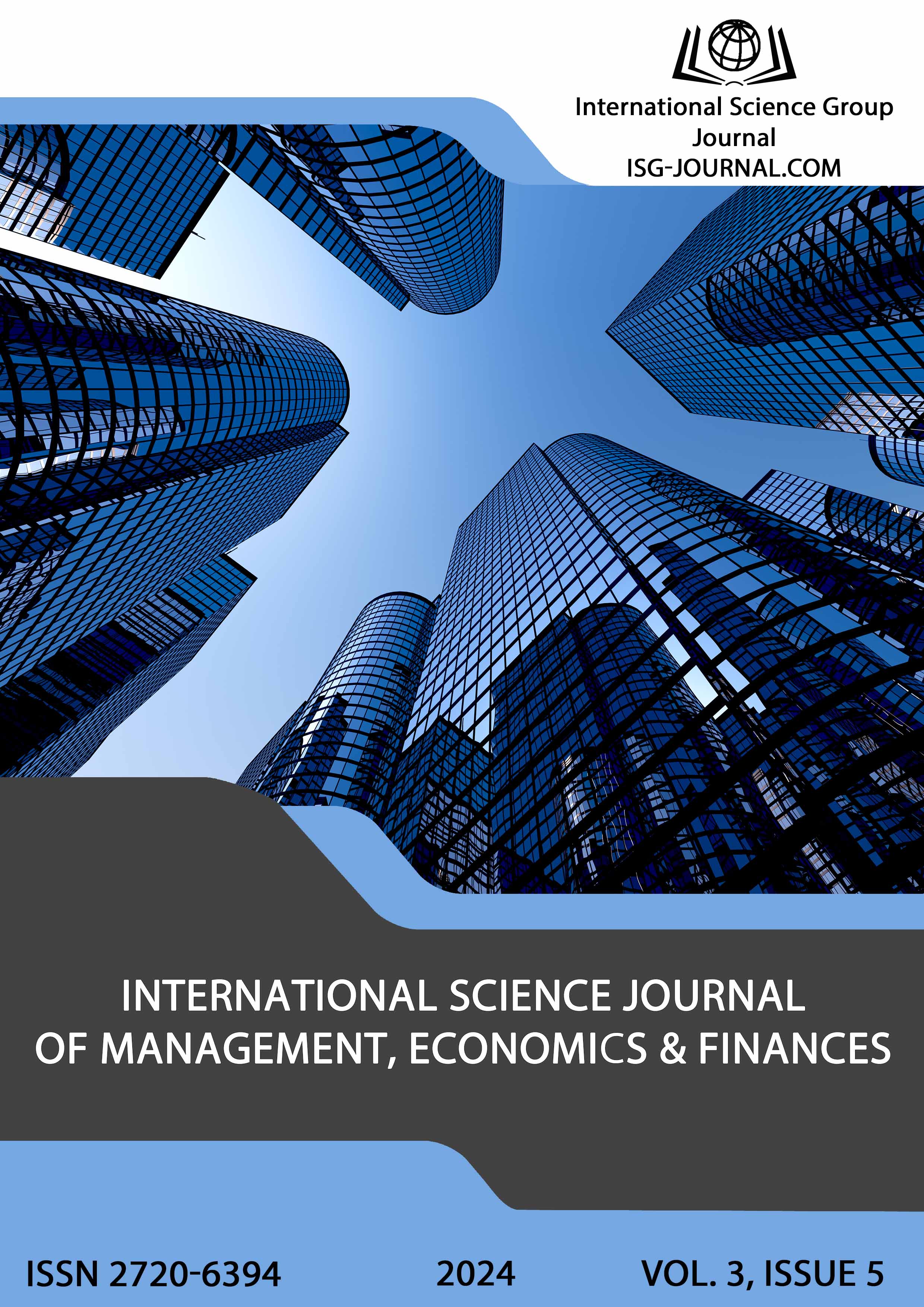Theoretical aspects of the analysis and prevention of risks of enterprise bankruptcy
DOI:
https://doi.org/10.46299/j.isjmef.20240305.03Keywords:
financial indicators, risk of bankruptcy, probability of bankruptcy, financial rehabilitation, crisis conditionAbstract
The relevance of the research lies in the fact that in conditions of economic instability and sanctions among states, even the most self-confident companies are not immune to the risks of bankruptcy and financial instability. Bankruptcy is a complex multi-stage process, at the end of which both the complete financial recovery of an individual/legal entity and its liquidation as a business entity are possible. Bankruptcy of an enterprise is allocated to a separate direction within the bankruptcy of legal entities, as it is often associated with obligations not only to creditors, but also to employees. Every organization aims at financial independence and prosperity, but this phenomenon is becoming very difficult every year, because the number of companies is growing, and therefore competition in all areas of activity is growing. It is because of these circumstances that companies begin to respond sensitively to any changes in market activity. As a result of changes and processes taking place in the market, companies increasingly have to face the risks of instability, financial dependence, and this leads to bankruptcy. Bankruptcy diagnostics are used to prevent financial collapse. It implies a comprehensive analysis of the company's work, including management activities, the circulation of funds and external factors. This tool is used by managers and leaders of companies at the initiative of owners and creditors. The benefit of diagnostics consists in minimizing the costs of overcoming the crisis, in predicting crisis phenomena and preventing consequences, and in selecting the most effective solutions based on the results of the analysis. The ultimate goal of bankruptcy diagnostics is to identify the risks of future failure of the enterprise and ways to eliminate them.References
Altman E.I. (1998). Financial Ratios, Discriminant Analysis and the Prediction of Corporate Bankruptcy.The Journal of Finance., pp. 589-609. doi: https://www.scirp.org/reference/referencespapers?referenceid=1269927
Терещенко О. О. ( 2009) Фінансова санація та банкрутство підприємств: навч. посіб. Київ: КНЕУ, 412с. doi: http://education.bukuniver.edu.ua/pluginfile.php/1519/mod_page/content/93/finansova_sanaciya_ta_bankrutstvo_pidpr_tereshenko.pdf
Правове регулювання банкрутства (Еd)/ (2009). Л. С. Сміян. – К. : КНТ. 464 с. doi: http://lib.puet.edu.ua/index.php?option=com_content&view=article&id=831:2013-08-01-11-45-19&catid=16&Itemid=39
Гук О. В. (2006). Сутність та причини банкрутств підприємств. Вісник Національного університету "Львівська політехніка"/ № 575. С. 58-64. doi: http://www.market-infr.od.ua/journals/2019/37_2019_ukr/36.pdf
Тридід О. М., Тижненко О. Г., Тижненко Л. О. ( 2011). Економіко-математичні моделі оцінки фінансового стану суб’єктів господарювання. Київ: УБС НБУ. 213 с. doi: https://irbis-nbuv.gov.ua/cgiin/irbis_nbuv/cgiirbis_64.exe?Z21ID=&I21DBN=EC&P21DBN=&S21STN=1&S21REF=10&S21FMT=JwU_B&C21COM=S&S21CNR=20&
Вечірко І. О. (2008). Мирова угода у справі про банкрутство: основні стадії та процесуальні особливості / І. О. Вечірко // Вісник господарського судочинства. № 6. С. 20-26. doi: http://lib.rada.gov.ua/static/about/bibl_ukazat/09_bankrut.html
Квасницька Р.С., Кордонець І.М. (2011). Етапність проведення діагностики кризового стану та ймовірності банкрутства підприємства. Вісник Хмельницького національного університету. № 2. С. 130–135. doi: http://journals.khnu.km.ua/vestnik/pdf/ekon/2011_2_3/130-135.pdf
Пластун О.Л. (2005). Аналіз кількісних методик прогнозування банкрутства підприємства та обґрунтування необхідності розробки сучасних вітчизняних аналогів. Вісник Української академії банківської справи. № 2. С. 101–107. doi: https://essuir.sumdu.edu.ua/bitstreamownload/123456789/54614/6/Plastun_Analiz_kilkisnykh_metodyk_prohnozuvannia.pdf
Томма Р.П., Шевчук О.О. (2015). Поняття та наслідки фіктивного банкрутства як заходу економічної відповідальності господарюючого суб’єкта. Науковий вісник Міжнародного гуманітарного університету. Вип.15(2). С. 65-67. doi: https://vestnik-pravo.mgu.od.ua/archive/juspradenc15/part_2/20.pdf
Бутирська І. А. (2015). Класифікація учасників провадження у справі про банкрутство І. А. Бутирська Санація та банкрутство. № 1. С.191-122. doi: https://drive.google.com/file/d/1GcLOnJXlpjmknymm6bSiBU37OQR3oxyi/view
Вечірко І. (2008). Господарський суд як суб’єкт процесуальних правовідносин у провадженні у спрвах про банкрутство / І. Вечірко // Підприємництво, господарство і право. С.21-26. doi: https://dspace.oduvs.edu.ua/server/api/core/bitstreams/421af587-a9bb-4884-9693-afb4f9468c6b/content
Про відновлення платоспроможності боржника або визнання його банкрутом» (1992) Закон України №2343-XII. Відомості Верховної Ради України (ВВР). № 31. С. 440. doi: https://zakon.rada.gov.ua/laws/show/2343-12#Text
Козирєва В.П. Н.В. Філик, А.П. Гаврилішин.(2022). Правове регулювання неплатоспроможності та банкрутства: навч. посіб. К.: Вид-во Нац. авіац. ун-ту «НАУ-друк»,296с. doi: https://profbook.com.ua/index.php?route=product/product/download&product_id=8785&download_id=1739
Поляков Б. М. (2005). Законодавство України про банкрутство: теорія та практика його застосування К.: Юридична думка doi: https://supreme.court.gov.ua/userfiles/media/Jukov_Zbirka_Bankrut_v2_191007_out.pdf
Селезньова Г., Чумак Г. (2022). Вплив розвитку цифрової економіки на конкурентне середовище вітчизняних підприємств. Підприємництво та інновації. № 25. С. 69-74. doi: http://ei-journal.in.ua/index.php/journal/article/view/544
Downloads
Published
How to Cite
Issue
Section
License
Copyright (c) 2024 Hanna Sobolieva

This work is licensed under a Creative Commons Attribution 4.0 International License.






